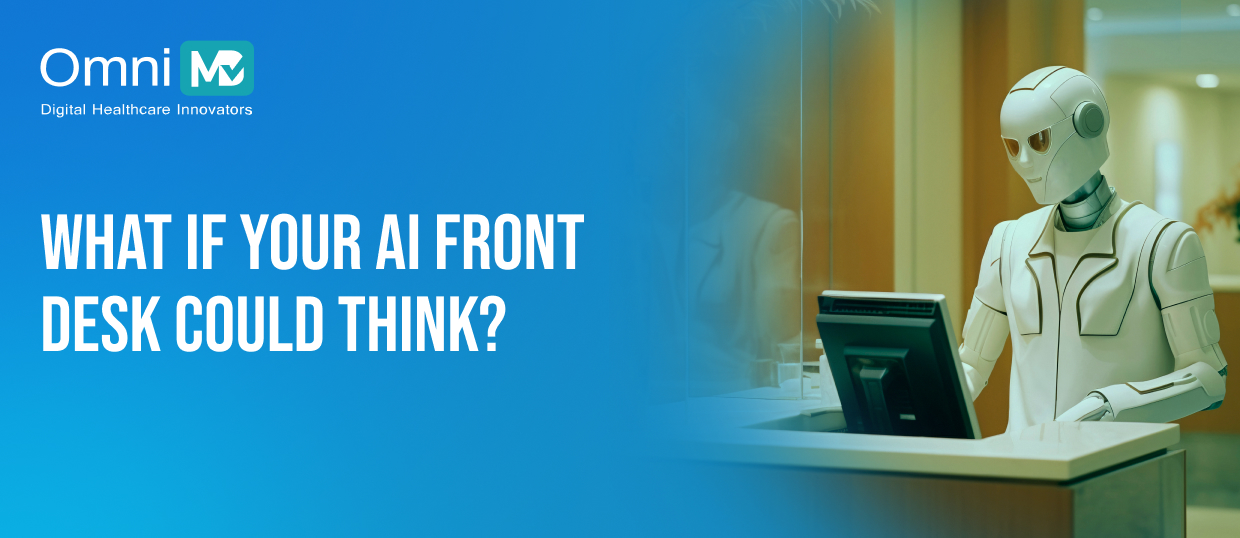How AI Front Desk Can Reduce New Patient Onboarding Time by Half
What if your first impression at a clinic is about waiting? A single new patient spends about 40 to 50 minutes before meeting a doctor. This is time spent on steps that feel necessary yet tiring. A typical breakdown looks like this:
| Step | Average Time | Description |
| Paper or digital form filling | 10 minutes | Patient completes forms at the counter |
| Insurance verification | 15 minutes | Receptionist checks eligibility by phone or portal |
| Manual entry of demographics | 10 minutes | Typing data into EHR or PMS |
| Scheduling confirmation | 5 minutes | Adjusting provider slot availability |
| Queue and internal coordination | 5 to 10 minutes | Routing information, printing face sheets |
That is 40 to 50 minutes of pre-care time. But none of it directly heals the patient.
When Artificial Intelligence entered this space, many expected only minor improvement. People thought it would just automate a few clicks or send reminders. What happened was much deeper. AI changed how these steps happened. It did not make receptionists work faster. It made time itself flow differently inside the clinic.
Before exploring how an AI front desk cuts onboarding time by half, it helps to remember what life looked like when every second was handled by hand.
The Early Digital Era. Why Computers Did Not Fix It.
When computers arrived in clinics, everyone expected miracles. Receptionists imagined a screen that would remember patients, type faster, and remove paperwork. What followed was a different kind of waiting.
The screen became another layer between people. Each task that once needed a pen now needed a login. A single visit involved several software tools. One for scheduling, one for billing, one for electronic health records. The receptionist kept switching tabs, copying numbers from one window to another.
In theory, this was progress. Files were safer and legible. Insurance information stayed stored for future visits. But the total time did not fall much. It only shifted location. Instead of standing in line for forms, patients waited for data entry to finish.
A routine visit still looked like this:
- Log in to multiple portals and confirm the patient’s details.
- Re-type information from the paper form into the digital chart.
- Upload scanned IDs and insurance cards.
- Wait for the insurance portal to respond.
- Cross-verify codes with the billing system.
What truly changed the story came years later when Artificial Intelligence entered quietly into the same workspace. Unlike software that waited for input, AI began to think, anticipate, and act while people worked. The difference was structural.
The AI Front Desk. What Really Changes.
When AI systems joined the reception desk, they did something that earlier tools never could. They worked before the patient arrived.
Today, many clinics send a link or message once an appointment is booked. The patient opens it, uploads an insurance card, confirms basic information, and signs consent digitally. The AI engine checks the uploaded data instantly, verifies coverage through direct connections with insurance databases, and stores every detail inside the electronic record. By the time the patient walks in, the clinic already knows who they are and what coverage they hold.
Inside the clinic, the receptionist now watches a single dashboard instead of juggling screens. The AI identifies incomplete information and prompts quick fixes. It also reads appointment types and automatically updates the provider’s schedule. The process that once happened in steps now unfolds together.
The time impact becomes clear through simple calculation:
| Function | Traditional Time | With AI | Time Saved |
| Form filling at front desk | 10 minutes | 0 (done online before arrival) | 10 |
| Insurance verification | 15 minutes | 3 to 5 seconds real-time API check | 14 |
| Data entry | 10 minutes | 2 minutes (auto-sync) | 8 |
| Scheduling confirmation | 5 minutes | 1 minute (smart match) | 4 |
| Queue coordination | 5 minutes | Automated notification | 5 |
| Total | 45 minutes | 18 to 20 minutes | 50 to 60 percent saved |
In a day with thirty patients, this saving equals around twenty minutes per patient, which means six hundred minutes gained. That is ten working hours returned to the clinic daily.
More than speed, this creates calm. The receptionist no longer rushes. The patient no longer repeats information. The front desk begins to feel human again.
AI Front Desk and Its Impact on Billing Accuracy, Data Integrity and Patient Mood
When the rhythm of a front desk changes, everything downstream begins to move differently.
Time saved at the counter reshapes how information flows, how money circulates, and how patients feel.
1. Billing Accuracy
With AI, errors that once traveled unnoticed into the billing cycle are intercepted at the source.
| Stage | Before AI | With AI | Result |
| Eligibility check | Manual, 15 min | Real-time API validation | 90% error reduction |
| Claim rejection rate | 12–14% | 3–4% | +10% clean-claim gain |
| Revenue cycle time | 14 days | 8 days | 6-day faster turnaround |
For a clinic billing $400,000 monthly, this accuracy adds up to nearly $40,000 in recovered revenue every month.
2. Data Integrity
A mistyped birth date, a flipped digit in an insurance ID, these were ordinary mistakes in manual data entry, where accuracy averaged around 93 to 94%. AI raised that number to 99.8%. It verifies, validates, and syncs data across systems before human eyes ever catch it.
What does a 5% improvement really mean?
In a clinic seeing 30 patients a day, that’s 900 encounters a month, and roughly 45 potential errors avoided every month. Each one could have triggered hours of rework, rebilling, or compliance review. Over a year, AI silently saves more than 500 administrative hours, simply by ensuring data stays correct from the start.
3. Patient Mood
A smoother check-in might seem technical, but emotionally, it redefines the visit. AI reduces average waiting time by nearly 15 minutes per patient, turning what used to be tension into calm.
Survey data from clinics shows how these minutes reshape perception:
| Experience Metric | Before AI | After AI |
| Overall satisfaction (1–10) | 7.4 | 9.1 |
| “Easy process” mentions | 22% | 58% |
| “Felt rushed” complaints | 18% | 4% |
The change is psychological. A patient who doesn’t wait is more open, more trusting, and more receptive to care. The visit begins in a state of ease rather than endurance.
Closing Thought. How Half the Time Scales to Double the Care.
Saving time for one patient may not sound like a revolution. Saving time for every patient changes the scale of what a clinic can do.
Let us take a small clinic that handles about thirty new or returning patients each day. Before AI, each onboarding took around forty minutes. That equals about 1,200 minutes, or 20 total hours of front-desk work in one day.
After AI, onboarding drops to about twenty minutes per patient. The total time now becomes 600 minutes, or 10 hours. The difference is 10 hours saved per day.
Over one month with twenty-two working days, that becomes 220 hours saved. In staff terms, this equals more than one full-time employee’s monthly workload. The same staff now complete twice as many patient check-ins without burnout or overtime.
This efficiency shows its real value when seen across operations:
| Activity | Before AI | After AI | Outcome |
| Average onboarding time per patient | 40–45 minutes | 18 to 20 minutes | Nearly half |
| Patients handled per day | 30 | 50 to 55 | More throughput |
| Average patient wait | 25 minutes | 8 to 10 minutes | Happier experience |
| Staff workload hours | 20 per day | 10 per day | 50% lighter load |
| Revenue cycle delay | 14 days | 8 days | Faster billing cycle |
These numbers are indicators of flow. The saved time also creates opportunities that did not exist before. Receptionists now have space to follow up on feedback, help patients with portal logins, and support providers with pre-visit prep. This additional care layer deepens the relationship between clinic and patient.
Some clinics choose to use these savings differently. A few add new services like wellness consultations or extended counseling hours. Others open early slots for same-day visits. The shared advantage is that none of these require extra staff or infrastructure. They grow from reclaimed time.
The math of ‘half the time’ turns into the emotion of ‘double the care.’ Each minute saved at the desk becomes a minute available for something more meaningful. A clinic that once rushed to stay on schedule now has space to listen, educate, and guide.
Over the span of a year, these minutes accumulate into hundreds of hours that shape patient loyalty and staff satisfaction. The result is a cycle that feeds itself, less waiting builds trust, trust brings repeat visits, and repeat visits strengthen stability.
That is how an AI front desk proves its real worth. It multiplies care without multiplying cost.

Cut Patient Onboarding Time by 50%
Discover how AI Front Desk automation transforms scheduling, intake, and patient experience from day one.

 Written by Kamal Sharma
Written by Kamal Sharma